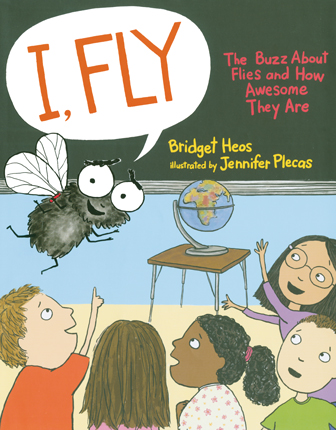| I, fly : the buzz about flies and how awesome they are Author: Heos, Bridget | ||
| Price: $23.08 | ||
Summary:
Fly is fed up with everyone studying butterflies. After all, flies go through metamorphosis too--and they are so much cooler! They flap their wings 200 times a second, compared to a butterfly's measly five to twelve times. Their babies--maggots--are much cuter than caterpillars (obviously). And when they eat solid food, they even throw up on it to turn it into a liquid. Both funny and informative, this narrator provides a new perspective on his fascinating species.
| Illustrator: | Plecas, Jennifer |
| Accelerated Reader Information: Interest Level: LG Reading Level: 3.20 Points: .5 Quiz: 173356 | Reading Counts Information: Interest Level: K-2 Reading Level: 2.20 Points: 2.0 Quiz: 66015 | |
Reviews:
Kirkus Reviews (12/15/14)
School Library Journal (12/01/14)
Booklist (12/15/14)
The Bulletin of the Center for Children's Books (+) (06/15)
The Hornbook (00/03/15)
Full Text Reviews:
School Library Journal - 12/01/2014 Gr 2–4—A whimsical approach to the life cycle of flies. Large, colorful illustrations immediately engage readers through dialogue bubbles and colorful cartoons. Children learn all about eggs, larva, pupa, and adulthood through the narration of one fly who resents how much attention butterflies get: "Well, guess who else metamorphoses, can fly, and is beautiful (at least according to my mother)." Understudied and not as well liked, the fly is shown to be an important insect that greatly aids in decomposition and composting; the author includes discussion of maggots, rotting fruit, and environmentalism and dispels the myth that flies are dirty insects. Readers learn how the bugs help solve police crimes and how they further the study of science in the lab. This book will be a lively read-aloud to introduce students to environmentalism or to generate conversation and new ideas and will be enjoyed by independent readers.—Tracey Wong, P.S. 54/Fordham Bedford Academy, Bronx, NY - Copyright 2014 Publishers Weekly, Library Journal and/or School Library Journal used with permission.
Booklist - 12/15/2014 A housefly buzzes into a classroom to find the students learning about butterflies. “I get it,” he sighs. “They have such beautiful wings.” But onto his teeny tiny soapbox he hops to make a case for the fascinating fly. Flies, you know, metamorphose the same as butterflies, only instead of being called caterpillars, they are called maggots—what’s the big deal? “Our mom tucked us into a warm, smelly bed of dog doo,” recalls the fly. These “short, greasy white worms” reproduce at a rapid rate, and within days a single fly can spawn thousands of “grandmaggots.” Suitably impressed, the students pepper the fly with questions. Do flies really vomit on food before eating it? Do they really spread disease? Well, yes—but, hey, blowflies and maggots help police solve crimes, too, so it all evens out! Like the author’s What to Expect When You’re Expecting Larvae (2011), this is giggly, gross, and educational, helped along by Plecas, who depicts our protagonist as a wide-eyed, hard-luck guy just trying to make a living. By, you know, eating poop and whatnot. - Copyright 2014 Booklist.
Bulletin for the Center... - 06/01/2015 To paraphrase Rodney Dangerfield, “Flies don’t get no respect,” and the fly narrator of this humorous and informative title believes they are worthy of more attention. Through word bubbles and the book’s text, the fly describes the many qualities that make flies a species worth studying, from their humble beginnings (“Scientists called us larvae. Humans called us maggots. Our parents called us adorable”) to their metamorphosis, flight skills, and remarkable reproduction rate. Heos has a knack for selecting and presenting the kind of factual information that is both fascinating and revolting (in other words, perfect for middle-graders), such as her blithe declaration that the fly’s “mother tucked us into a warm, smelly bed of dog doo,” or that a fly will “throw up” on solid foods in order to break them down for slurping up with its “spongy mouth.” Plecas’ pictures, created using traditional media and Photoshop, also keep the tone light while still being instructive, as the bulbous-eyed, shaggy gray fly makes his case before a diverse class of attentive students. The fly’s apologetic eyebrows give him a charmingly imploring look that will go a fair way towards making his species less repugnant to youngsters. For maximum info-tainment value, pair this with Gravel’s similarly themed but less comprehensive The Fly (BCCB 5/14). An amusing glossary, a select bibliography, and a list of consulted experts are included. JH - Copyright 2015 The Board of Trustees of the University of Illinois.



